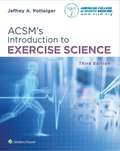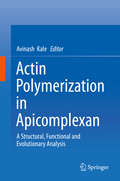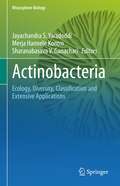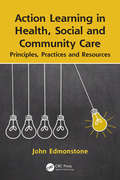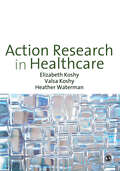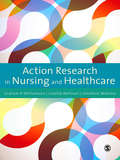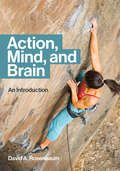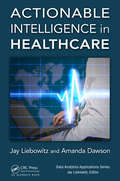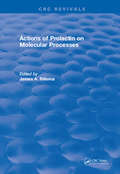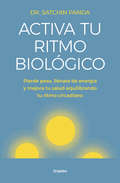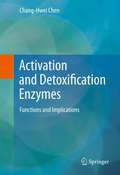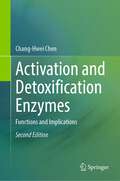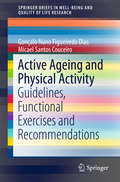- Table View
- List View
Acsm's Introduction To Exercise Science
by Jeffrey A. Potteiger<P>Succeed in your course and learn more about potential careers with ACSM's Introduction to Exercise Science, 3rd Edition.<P> This proven book provides an engaging, up-to-date overview of exercise science and related areas, such as athletic training and sports medicine.<P> In every chapter, the author illustrates the importance and clinical relevance of each topic in the curriculum and gives you an insider's view of the profession through fascinating interviews and online video profiles and fieldtrips.<P> As an American College of Sports Medicine publication, this full-color resource offers the unsurpassed quality and excellence that has become synonymous with titles by the leading exercise science and sports medicine organization in the world.<P> NEW! A brand-new chapter shows how research is conducted, provides an overview of research as a career pursuit, and explores the concept of evidence-base practice.<P> Video fieldtrips take you into different real-world settings to learn about exercise science careers.<P> UPDATED! Interviews and video profiles of rising stars in the exercise science profession and working healthcare professionals (a dietician, cardiologist, exercise physiologist, etc.) demonstrate the challenges and rewards of careers that begin with an exercise science degree. UPDATED! The "Future of Exercise Science" chapter now reflects the latest trends in the field.<P> Features important updates related to the 10th edition of ACSM's Guidelines for Exercise Testing and Prescription.<P> REVISED! The motor behavior chapter is now more meaningful, relevant, up-to-date, and understandable.<P> Chapter objectives, key terms and definitions, chapter summaries, and Thinking Critically boxes help you master key concepts.
Act and Omission in Criminal Law: Autonomy, Morality and Applications to Euthanasia (Routledge Research in Legal Philosophy)
by Roni RosenbergThis book offers an innovative perspective on the critical distinction between acts and omissions in criminal law, a distinction that runs like a defining thread through all types of criminal offenses.While any act that positively causes a prohibited harm is sufficient for a conviction, an omission that causes the very same harm warrants a conviction only when there is a legal duty to act. This fundamental distinction between acts and omissions is not just relevant to criminal law, but it is also deeply rooted in our moral thinking. Thus, it is commonly argued that the difference between acts and omissions is also applicable to the intuitive moral distinction between active euthanasia, forbidden in most countries, and passive euthanasia, permitted in many countries under certain circumstances. Hence, the significance of this book is threefold: First, it offers a comprehensive, coherent, and systematic discussion of the intersections between the philosophical-moral and the legal-criminal aspects of this fundamental topic. Second, it offers a novel rationale for the distinction between acts and omissions, based on the principle of autonomy. Finally, it demonstrates the influences of the theoretical discussion, on the most significant practical questions.This book will be of interest to researchers, academics and policy-makers working in the areas of criminal law, moral philosophy, and bioethics.
Actin Polymerization in Apicomplexan: A Structural, Functional and Evolutionary Analysis
by Avinash KaleThis book discusses in detail the structural, evolutionary and functional role of actin and its regulatory proteins in gliding motility in apicomplexan organisms, a unique phenomenon found in actin-myosin cytoskeletal elements. The book also explores the potential of different actin regulators, namely formin, profilin, actin depolymerization factor (ADF), capping proteins (CPα and CPβ), cyclase-associated protein (CAP) and coronin 13–24 as potential drug targets against malaria. As the chief components of the gliding motor, the actin-regulator proteins are characterized by unique features that make them promising targets for structure-based drug design. Lastly, the book proposes a mathematical model, based on kinetic data mining, to help understand the most vital regulators for actin polymerization dynamics.
Actin-based Motility: Cellular, Molecular and Physical Aspects
by Marie-France CarlierThis book presents the cellular, molecular and physical aspects of production of force and movement by self-assembly of actin, one of the most abundant protein in cells, into cytoskeletal filaments. « Actin-based motile processes » are responsible for a very large variety of motile activities of cells in their physiological and pathological states, covering chemotactic locomotion, embryonic and metastatic cell migration, wound healing, eukaryotic cytokinesis and bacterial plasmid segregation, endocytic and phagocytic activities, as well as morphogenetic processes like axis patterning in early embryo, axonal growth in brain development, immune response and synaptic plasticity processes at the origin of learning and memory. The different chapters of the book describe how the multidisciplinary multiscale approaches taken in the recent years have explored the molecular and physical mechanisms at the origin of force and movement produced by actin self-assembly. The chosen topics show how advances have been made in the field of cell motility due to progress in live cell imaging, light microscopy, improved resolution in the structure of large protein assemblies, biochemical analysis and mathematical modeling of actin assembly dynamics and development of nanotechnologies allowing to measure forces in the range of pico- to nano-newton produced by actin assemblies.
Actinobacteria: Ecology, Diversity, Classification and Extensive Applications (Rhizosphere Biology)
by Jayachandra S. Yaradoddi Merja Hannele Kontro Sharanabasava V. GanachariThrough this book, the readers will learn about the different aspects of Actinobacteria- beginning with its ecology and occurrence, to the ways of its adaptation to harsh climates, and finally to its practical applications. The book also presents methods of identifying and characterizing this diverse group of bacteria through advanced techniques like MALDI-TOF, 16S rRNA analysis, etc. Different chapters describe the various biotechnological applications of Actinobacteria, including bioremediation, secondary metabolite production, and in producing antibiotics, anti-cancer therapeutics. It also provides insights into the applications in agriculture and forestry by inhibiting plant pathogenic bacteria's growth.
Actinomycetes in Marine and Extreme Environments: Unexhausted Sources for Microbial Biotechnology
by D. İpek KurtbökeThe discovery and development of antibiotics has been one of the most significant advances in medicine. In a golden era lasting from the 1940s to the late 1960s, antibiotic research provided mankind with a wide range of structurally diverse and effective agents for the treatment of microbial infections. Since then, actinomycetes, most notably members of the genus Streptomyces, have uninterruptedly proved to be a particularly rich source of antibiotics and other therapeutic and biotechnologically important compounds. This book brings together expert actinomycetologists to communicate the importance of finding novel antibiotic producing actinomycetes in extreme and marine environments in the light of molecular advances.
Action Evaluation of Health Programmes and Changes: A Handbook for a User-Focused Approach
by John ØvretveitHealthcare Performance and Organisational Culture examines the evidence for a relationship between organisational culture and organisational performance in the health care sector. This book provides essential information to assist health managers improve the performance of their organisation by addressing the factors of style and culture, using practical tools throughout to measure them and link them to performance. It comprehensively examines the theoretical basis of the relationship between organisational culture and performance and assesses the various tools designed to measure or assess the culture of organisations. All healthcare professionals and clinicians with management responsibilities will find this book essential reading.
Action Learning in Health, Social and Community Care: Principles, Practices and Resources
by John EdmonstoneThis comprehensive guide covers all aspects of action learning, one of the most widely used development methods in health, social and community care. The book addresses the theory and practice of action learning in these fields, and considers action learning as an adult educational ethos as well as a helpful tool. Based upon emerging experience, it identifies good practice in action learning and offers a wide range of resources to enable individuals and organisations extract maximum benefit from this approach. Offering practical tips grounded in sound educational principles, this book is invaluable reading for all senior managers and professionals considering using action learning for leadership, management and organisation development purposes, including organisation development practitioners and action learning facilitators, and for medical and healthcare educators and their counterparts in social and community care looking for a general introduction to this growing field.
Action Learning in Healthcare: A Practical Handbook
by John EdmonstoneAction learning was developed in the UK in the 1960s and is now one of the most widely used development methods in healthcare. This practical manual embodies the dual focus of action learning as both philosophy and technique - exploring the underlying concepts derived from adult education and organisation development, addressing challenges and providing invaluable support material. Specifically targeting the healthcare sector, this book is divided into three parts: an exploration of core ideas and underlying assumptions including techniques and methods; practice-preparation, projects, sets, facilitation and evaluation; and a compendium of resources. Action Learning in Healthcare is vital reading for senior managers and professionals considering using action learning for leadership, management and organisation development purposes. It is also highly recommended for organisation development practitioners (with responsibility for project managing the use of action learning in local and national programmes). Action learning facilitators, too, will find much to absorb, modify and use in their own practice, as will action learning set members wishing to enhance their knowledge.
Action Research for Nurses
by Jean McNiff Peter McDonnellNurses work in complex situations with daily challenges, where the needs of each patient represent unique demands. Action research helps nurses to investigate their practices as reflective practitioners, allowing them to ask ‘What is going on? How do we understand the existing situation? How do we improve it?’ This book supports nurses in investigating their own professional practices in order to develop the new insights and approaches: · embodying holistic perspectives in dialogical and relational forms of individual and organisational learning, · equal emphasis on processes and outcomes; · welcoming all participants’ contributions , and listening to all voices; · developing a patient-centred focus where people are involved in their own healing; · building communities of enquiring practices. This book is intended for undergraduate student nurses, qualified practising nurses in clinical settings who may or may not be engaged in formal professional education courses and nurse educators and managers.
Action Research for Nurses
by Jean Mcniff Peter McdonnellNurses work in complex situations with daily challenges, where the needs of each patient represent unique demands. Action research helps nurses to investigate their practices as reflective practitioners, allowing them to ask 'What is going on? How do we understand the existing situation? How do we improve it?' This book supports nurses in investigating their own professional practices in order to develop the new insights and approaches: · embodying holistic perspectives in dialogical and relational forms of individual and organisational learning, · equal emphasis on processes and outcomes; · welcoming all participants' contributions , and listening to all voices; · developing a patient-centred focus where people are involved in their own healing; · building communities of enquiring practices. This book is intended for undergraduate student nurses, qualified practising nurses in clinical settings who may or may not be engaged in formal professional education courses and nurse educators and managers.
Action Research in Healthcare
by Heather Waterman Dr Elizabeth Koshy Dr Valsa KoshyAction Research in Healthcare is a practical guide to using research for improving practice in healthcare contexts. As an increasingly popular method of inquiry, action research is widely used in healthcare to investigate professional practice and patients' experience while simultaneously: - introducing innovations - planning, actioning and evaluating new ideas - seeking to improve patient care - working collaboratively. Taking you through the process step-by-step, Action Research in Healthcare explains how to tackle each stage of your project - from planning the study and undertaking a literature review, through to gathering and interpreting data and implementing findings. Examples of action research projects are included throughout to illustrate how the method works in practice. Action Research in Healthcare assumes no previous knowledge of the subject and is the ideal resource for anyone about to start or already involved in a project.
Action Research in Nursing and Healthcare
by Dr Loretta Bellman Jonathan Webster Graham WilliamsonAction Research is becoming more popular in nursing and healthcare. It is used by practitioners who want to better understand and improve the quality of their work, and by students who need to do a research project for their course. An Action Research approach enables evidence-based care and links research directly to practice, making it the ideal method for a researcher in these fields. This book introduces readers to Action Research by presenting its key concepts and backing these up with practical examples throughout, often drawn from the authors' own extensive experience. Topics include: - Action research to advance patient care - Collaborative working - Ethics - Participatory Action Research - Writing up and disseminating projects Williamson, Bellman, and Webster - leading figures in the field - provide practical advice for using Action Research in healthcare settings, with patients and alongside other practitioners. Their book presents a flexible approach that can be adapted to researchers' real needs.
Action, Mind, and Brain: An Introduction
by David A. RosenbaumAn engaging and accessible introduction to the psychology and neuroscience of physical action.This engaging and accessible book offers the first introductory text on the psychology and neuroscience of physical action. Written by a leading researcher in the field, it covers the interplay of action, mind, and brain, showing that many core concepts in philosophy, psychology, neuroscience, and technology grew out of questions about the control of everyday physical actions. It explains action not as a &“one-way street from stimuli to response&” but as a continual perception-action cycle. The informal writing style invites students to think through the evidence step by step, helping them develop general thinking stills as well as learn specific facts. Special emphasis is placed on the role of underrepresented groups. The book discusses the intellectual background of the field, from Plato to Kant, Dewey, and others; applications and methods; and the physical substrates of action—bones, tendons, ligaments, muscles, and nerves. It considers the control of actions in space; learning, and the roles of nature and nurture; feedback; feedforward, or anticipated feedback; and degrees of freedom—the multiple ways of getting things done and three methods for narrowing the alternatives. The book is generously illustrated, including many images of thinkers who contributed to the field.
Action, Perception and the Brain
by Jay SchulkinTheories of brain evolution stress communication and sociality are essential to our capacity to represent objects as intersubjectively accessible. How did we grow as a species to be able to recognize objects as common, as that which can also be seen in much the same way by others? Such constitution of intersubjectively accessible objects is bound up with our flexible and sophisticated capacities for social cognition understanding others and their desires, intentions, emotions, and moods which are crucial to the way human beings live. This book is about contemporary philosophical and neuroscientific perspectives on the relation of action, perception, and cognition as it is lived in embodied and socially embedded experience. This emphasis on embodiment and embeddedness is a change from traditional theories, which focused on isolated, representational, and conceptual cognition. In the new perspectives contained in our book, such 'pure' cognition is thought to be under-girded and interpenetrated by embodied and embedded processes. "
Actionable Intelligence in Healthcare (Data Analytics Applications)
by Amanda Dawson Jay LiebowitzThis book shows healthcare professionals how to turn data points into meaningful knowledge upon which they can take effective action. Actionable intelligence can take many forms, from informing health policymakers on effective strategies for the population to providing direct and predictive insights on patients to healthcare providers so they can achieve positive outcomes. It can assist those performing clinical research where relevant statistical methods are applied to both identify the efficacy of treatments and improve clinical trial design. It also benefits healthcare data standards groups through which pertinent data governance policies are implemented to ensure quality data are obtained, measured, and evaluated for the benefit of all involved. Although the obvious constant thread among all of these important healthcare use cases of actionable intelligence is the data at hand, such data in and of itself merely represents one element of the full structure of healthcare data analytics. This book examines the structure for turning data into actionable knowledge and discusses: The importance of establishing research questions Data collection policies and data governance Principle-centered data analytics to transform data into information Understanding the "why" of classified causes and effects Narratives and visualizations to inform all interested parties Actionable Intelligence in Healthcare is an important examination of how proper healthcare-related questions should be formulated, how relevant data must be transformed to associated information, and how the processing of information relates to knowledge. It indicates to clinicians and researchers why this relative knowledge is meaningful and how best to apply such newfound understanding for the betterment of all.
Actions of Prolactin On Molecular Processes
by James A. RillemaIt is well established tht the intial interaction of prolactin with its target cells is with specific receptor molecules located on the external surface of the plasma membrane. Subsequent to the prolactin-receptor interaction, however, the molecular events that culminate in the regulation of biological processes are not totally understood. This book was assembled to review and analyse the currently available information relative to the molecular events involved in the actions of prolactin on cells. Hopefully, the assimilation of this information will provide the basis for ultimately determining the sequence of molecular reactions by which prolactin expresses its biological responses.
Actions, Styles, and Symbols in Kinetic Family Drawings (K-F-D): An Interpretative Manual
by Robert C. Burns S. Harvard KaufmanThis classic text focuses on the features of K-F-D that have emerged after more than 12 years of clinical experience with 10,000 drawings. One-hundred and thirty drawings are reproduced, showing common characteristics of K-F-D figures and the varied actions and symbols that reflect relations between family members. Included are a K-F-D Grid and an Analysis Sheet to assist clinicians in interpreting their own patients' K-F-Ds.
ActivEpi Companion Textbook: A supplement for use with the ActivEpi CD-ROM
by David G. Kleinbaum Kevin M. Sullivan Nancy D. BarkerThis Companion Textbook supplements the ActivEpi CD-ROM, sold separately. The ActivEpi CD-ROM provides a multimedia presentation of concepts, commonly taught in an introductory epidemiology course. ActivEpi mixes a full array of media to motivate, explain, visualize and apply epidemiological concepts. Virtually all of the material on the ActivEpi CD-ROM is included in the Companion Textbook. Because individuals differ in their learning skills, the ActivEpi CD-ROM and the ActivEpi Companion Textbook offer readers different but related options on how to learn epidemiology. The Textbook can be used as a hardcopy reference of the textual materials contained on the CD-ROM, as a resource for the practice exercises, as a general reference, or even a self-contained textbook. ActivEpi includes 15 lessons and over 50 hours of content via more than 250 launchable activities and homework exercises. It can be used in a variety of teaching formats: distance learning, self-paced learning, on-campus courses, and short courses. For the latest additions to ActivEpi, visit David Kleinbaum's website.
Activa tu ritmo biológico: Pierde peso, llénate de energía y mejora tu salud equilibrando tu ritmo circadiano
by Doctor Satchin PandaUn plan de salud basado en los estudios e investigaciones más recientes expuesto por el mayor experto en el tema a nivel mundial. Como la mayoría de las personas, probablemente te levantas por la mañana, sientes hambre a las horas que sueles comer y te acuestas más o menos a la misma hora todos los días. Si alguna vez no duermes o sufres jet lag, sabes que esta rutina se alterará. Pero para algunos, la dificultad para dormir por la noche, el hambre en momentos extraños o la fatiga repentina son una constante. Si eres una de esas personas, el Dr. Satchin Panda, uno de los principales investigadores en ritmos circadianos y pionero en el campo de la salud y la nutrición, tiene un método infalible para restablecer el equilibrio de tu cuerpo. Es un plan concreto para que además incrementa la pérdida de peso, mejora el sueño, optimiza el ejercicio y como administramos la tecnología para que no interfiera con el ritmo naturaldel cuerpo. Su método, ayuda a prevenir y revertir dolencias como la diabetes, el cáncer y la demencia, y también afecciones de microbioma como el reflujo ácido, la acidez estomacal y colon irritable. El Dr. Satchidananda Panda, es el principal experto mundial en el campo de la investigación del ritmo circadiano. Su investigación se centra en el efecto del reloj biológico sobre la fisiología del comportamiento y el metabolismo.
Activation and Detoxification Enzymes: Functions and Implications
by Chang-Hwei ChenHumans are exposed to foreign compounds such as drugs, household products and environmental chemicals by swallowing or breathing. Also, food is considered a foreign compound. Such foreign compounds can be non-essential and non-functional to life, and commonly are referred to as xenobiotics. Some xenobiotics are not toxic; however, many of them are potentially toxic or become toxic after conversion to metabolic intermediates. A considerable number of foreign compounds belong to non-polar, lipophilic substances. Lipophilic compounds are not soluble in water. Metabolic conversion of lipophilic foreign compounds to facilitate their removal from the body is essentially carried out by biochemical reactions catalyzed by two classes of metabolizing enzymes, namely, activation enzymes and detoxification enzymes. Activation enzyme-catalyzed functionalization reaction introduces a functional group to a lipophilic compound. Functionalization modifies many foreign compounds to form reactive intermediates capable of interacting with cellular components (proteins, DNA and lipids), leading to a variety of conditions for diseases. Functionalized compounds are further metabolized through detoxification enzyme-catalyzed reactions, which result in an increase in the solubility of parent compounds and an inactivation of metabolic intermediates, thus facilitating their excretion from the body. To minimize the exposure of potentially toxic metabolic intermediates, it is essential to keep them at a minimum level. Extensive investigations have revealed that foreign compound-metabolizing enzymes exhibit genetic polymorphisms. Variations in their activities can produce different results as to the susceptibility to potential toxic effects. Moreover, the expressions of activation enzymes and detoxification enzymes are inducible. A number of chemical compounds are capable of acting as modulators for these two classes of enzymes. These findings have lead to the proposal of modulating metabolizing enzymes as a useful approach for human health benefits. Importantly, many of these chemical compounds are present in human daily diets. There are many advances that have been made in the past decades towards the understanding of functions and implications of activation enzymes and detoxification enzymes. An organized, concise overview is needed for the readers who are initially exposed to this important subject, particularly for students and researchers in the areas of biomedical sciences, biochemistry, nutrition, pharmacology and chemistry. This book is intended to serve this purpose as an introduction to the subject. Furthermore, major topics in the book, excluding catalytic reactions and structural properties, may have interest to other readers who have knowledge of basic sciences and understanding enzyme related information. The book discusses subjects associated with foreign compound metabolizing enzymes with emphasis on biochemical aspects, including lipophilic foreign compounds, catalytic properties, reactive intermediates, biomedical and biochemical effects, genetic polymorphisms, enzyme inducibility, enzyme modulation for health benefits, dietary related enzyme modulators, and structural characteristics of enzyme inducers.
Activation and Detoxification Enzymes: Functions and Implications
by Chang-Hwei ChenThis book discusses the many advances in the understanding of the functions and implications of activation and detoxification enzymes. This organized, concise overview will meet the needs of those who are initially exposed to this important subject, particularly for students and researchers in the areas of biomedical sciences, biochemistry, nutrition, pharmacology, and chemistry. The book will also be valuable to advanced researchers. The book discusses subjects associated with foreign-compound-metabolizing enzymes with emphasis on biochemical aspects, including lipophilic foreign compounds, activation and detoxification enzymes, metabolic enzyme catalytic properties, reactive metabolic intermediates, biomedical and biochemical effects, genetic polymorphisms, enzyme inducibility, enzyme modulation for health benefits, dietary-related enzyme modulators, and structural characteristics of enzyme inducers. This new edition is updated throughout andfeatures completely new chapters on Oxidative and Electrophilic Stresses, Metabolite- Mediated Disease Conditions, and Defense Mechanism: Nrf2-ARE Pathway.
Active Ageing and Demographic Change: Challenges for social work and social policy
by Siniša Zrinščak and Susan LawrenceAlthough demographic change has been a widely discussed topic for decades, its scope, social impact and related policy responses leave us with many unresolved social issues. Demographic change is a reality for all European societies but the ways in which it is taking place differ from country to country. Active ageing both as a concept and policy response to the demographic ageing of populations has been widely debated, researched and utilised, informing both policy and practice, and providing a common narrative framework to ageing. However, there continues to be a lack of clarity around the precise meaning of ‘active ageing’.This book explores the way in which social work is critically engaging with the theme of active ageing, in light of, or maybe as a reaction to, the policy responses witnessed within the context of large-scale and rapid demographic change. This book was originally published as a special issue of the European Journal of Social Work.
Active Ageing and Physical Activity: Guidelines, Functional Exercises and Recommendations (SpringerBriefs in Well-Being and Quality of Life Research)
by Gonçalo Nuno Figueiredo Dias Micael Santos CouceiroThis book presents an analysis of active ageing and physical activity from a multidisciplinary perspective. With descriptions of exercises, adequately illustrated with pictures, this book shows that regular physical activity reduces the prevalence of chronic diseases associated with ageing, as well as the risk of morbidity and mortality of the elderly. It confirms that exercise programs minimize the psychomotor decline, prevent the loss of functionality, inability and dementia, and foster significant gains in health and well-being, leading to increased quality of life of the elderly.
Active Ageing in the European Union
by Kate A. HamblinThis book explores the adoption of 'active ageing' policies by EU15 nations and the impact on older peoples' work and retirement policy options. Policies examined include unemployment benefits, active labour market policies, partial pension receipt, pension principles, early retirement and incentives for deferral.
